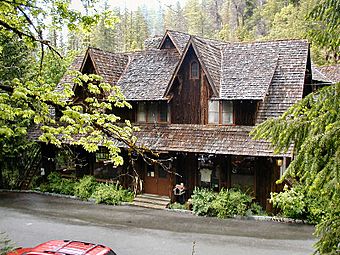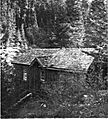Oregon Caves Historic District facts for kids
|
Oregon Caves Historic District
|
|

Oregon Caves Chateau
|
|
| Location | Oregon Caves National Monument |
|---|---|
| Nearest city | Cave Junction, Oregon |
| Area | Approx. 11 acres (4.5 ha) |
| Built | 1926–1942 |
| Architect | Gust Lium and Francis Lange |
| Architectural style | National Park Service Rustic |
| NRHP reference No. | 92000058 (original) 11001028 (increase) |
Quick facts for kids Significant dates |
|
| Added to NRHP | February 25, 1992 |
| Boundary increase | January 12, 2012 |
The Oregon Caves Historic District is a special area within the Oregon Caves National Monument in southern Oregon. It covers about 6 acres (2.4 hectares) where most visitors go. This district is important because of its unique buildings and the way the park landscape was designed. These buildings were made in a style called National Park Service Rustic, which means they look natural and fit into the environment. Because of this special design, the area was added to the National Register of Historic Places in 1992.
Contents
Discovering the Oregon Caves
The Oregon Caves were found in 1874 by a hunter named Elijah Davidson. He was hunting bears near a place now called Mount Elijah, named after him. It's possible that Native Americans knew about the caves before Davidson. However, there is no proof of anyone exploring or using them earlier. So, Elijah Davidson is known as the first person to enter the caves.
Making the Caves a National Monument
In 1907, a writer named Joaquin Miller visited the caves. He wrote an article that showed how beautiful and special the caves were. This article helped the caves become famous across the country. The U.S. Government then ordered a survey of the site. This survey was finished in 1908.
Because of the survey and continued support from Miller and other important people, the Oregon Caves became a National Monument. This happened in 1909, thanks to President William Howard Taft.
Developing the Park's Look
The United States Forest Service was in charge of the Oregon Caves National Monument starting in 1909. The caves were in a very remote spot. The first permanent road to the site wasn't finished until 1922. In 1934, the National Park Service took over the monument.
For the next nine years, the Park Service worked with the Civilian Conservation Corps (CCC). The CCC was a program that put young men to work on public lands during the Great Depression. They helped develop and landscape the Oregon Caves site. Their goal was to make it look like a "rustic alpine village" tucked into a mountain canyon.
The Park Service wanted a natural look for the buildings. They used local materials like stone and wood. Every part was carefully placed to show off the rugged feel of the canyon. They even used cedar-bark siding on all the buildings to make them look unified. While some small changes have happened over time, the buildings still have their unique rustic style. This style is made even better by the beautiful park landscape around them. In 1992, this special part of the Oregon Caves National Monument became a historic district.
Buildings in the Historic District
The buildings in the Oregon Caves Historic District show off the National Park Service Rustic architectural style. Most of these historic buildings are still in their original condition. Only a few small changes were made to fix damage from landslides or floods, or to meet safety rules. The Oregon Caves Historic District has four main buildings and two other structures.
The main buildings are:
- The Chalet, first built in 1924 and rebuilt in 1942.
- The Oregon Caves Chateau, built in 1934.
- The Guide Dormitory, built in 1927 with additions in 1940 and 1972.
- The Ranger Residence, built in 1936.
The most famous of these is the Chateau. It is so special that it is listed on the National Register of Historic Places all by itself.
Five of the six structures in the historic district are considered "contributing structures." This means they help make the district historically important. These include the four main buildings and an original Checking and Comfort Station. All these buildings were constructed between 1926 and 1942. They all share common features like rough-cut Port Orford cedar-bark siding, wood-shingled roofs, and rustic stone work.
- The original Oregon Caves Chalet was the first permanent building at the site, built in 1924. It was completely rebuilt in 1942. This project not only rebuilt the original structure but also added a third floor. It also got a large, gabled entrance called a breezeway. The new building was covered with the same cedar-bark siding used on other monument buildings. Today, the Chalet still looks much like it did then. The stone steps in front were changed to concrete for safety. The first floor is now a visitor center. The top two floors are still used as a dormitory for seasonal guides.
- The Oregon Caves Chateau was finished in 1934. It was built by Gust Lium, a builder from Grants Pass, Oregon. The Chateau is a complex building with six stories and ten sides, built on a slope. It was first used as the National Park Service headquarters and a place for visitors to stay. Today, the Chateau still offers overnight lodging and services for visitors. It also has a coffee shop, a restaurant, and a gift shop. A part of Cave Creek actually flows through the building, creating a cool water feature in the dining room. The original wooden porches were replaced with steel fire escapes in 1958. Even with these changes, the Chateau is one of the best-preserved rustic lodges in the national park system.
- The Guide Dormitory was built in 1927. It is located north of the Chateau and northwest of the Chalet. This building is made of wood with pointed dormers above the second-story windows. Additions in 1940 and 1972 almost tripled the building's size. However, the original part of the building is the oldest structure in the historic district.
- Construction of the Ranger Residence began in late 1935 and finished in early 1936. It was built on a steep slope south and uphill from the Chalet. Francis Lange, a landscape architect from Crater Lake National Park, designed the building. It is a one-story house with a living room, a combined kitchen and dining room, and two bedrooms. In 1974, the building was changed to office space.
- The Checking and Comfort Station was built in 1941. It is a wood-frame building with cedar-bark siding. It is located near the monument's day-use parking area. Rustic stone work was added to the north side of the building in the 1960s. In 1979, the building was made handicapped accessible so people with disabilities could use it easily. Today, this building is used as a visitor contact center and has restrooms.
The Park's Natural Setting
The Oregon Caves National Monument is located on Mount Elijah, which is part of the Siskiyou Mountains. The monument covers about 480 acres (1.9 square kilometers). The elevation here ranges from about 3,800 feet (1,158 meters) to 5,450 feet (1,661 meters) above sea level. Cave Creek starts inside the Oregon Caves and comes out near the Chateau. The creek then flows west through a steep canyon and out of the monument.
The natural environment around the Oregon Caves Historic District has not changed much since the historic buildings were constructed. The way the site was designed and landscaped successfully made the historic buildings blend into nature. The Chalet and Chateau are located on a flat area near the cave entrance. The Ranger Residence and Guide Dormitory are on opposite sides of the canyon. There is a plaza area between the Chalet and Chateau. The landscaping and stone walls in the plaza provide shade and a rustic look. This helps highlight the main buildings of the historic district. Also, the thick forest around the area hides the service road, which adds to the district's natural, rustic feel.
How to Get There
The Oregon Caves Historic District is inside the Oregon Caves National Monument. The monument is in the Siskiyou Mountains in southwest Oregon. It is about seven miles (11 km) north of the Oregon-California border. You can reach it by driving about 20 miles (32 km) east of Cave Junction, Oregon on Oregon Highway 46. This highway ends at the monument's day-use parking lot.
The weather in the Oregon Caves area is usually mild. However, storms can happen suddenly and sometimes be very strong. Also, fog is common in the winter and early spring. The area gets about 50 inches (1.27 meters) of rain each year. The average annual snowfall is about 160 inches (4.06 meters). During winter, the access highway is often closed for a short time when there are heavy snowstorms.
Images for kids








